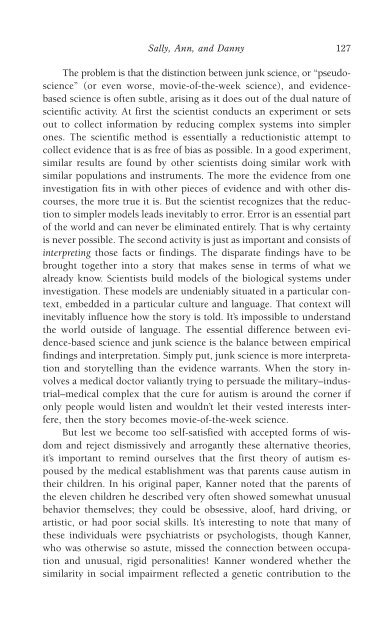978-1572305441
autism
autism
You also want an ePaper? Increase the reach of your titles
YUMPU automatically turns print PDFs into web optimized ePapers that Google loves.
Sally, Ann, and Danny 127<br />
The problem is that the distinction between junk science, or “pseudoscience”<br />
(or even worse, movie-of-the-week science), and evidencebased<br />
science is often subtle, arising as it does out of the dual nature of<br />
scientific activity. At first the scientist conducts an experiment or sets<br />
out to collect information by reducing complex systems into simpler<br />
ones. The scientific method is essentially a reductionistic attempt to<br />
collect evidence that is as free of bias as possible. In a good experiment,<br />
similar results are found by other scientists doing similar work with<br />
similar populations and instruments. The more the evidence from one<br />
investigation fits in with other pieces of evidence and with other discourses,<br />
the more true it is. But the scientist recognizes that the reduction<br />
to simpler models leads inevitably to error. Error is an essential part<br />
of the world and can never be eliminated entirely. That is why certainty<br />
is never possible. The second activity is just as important and consists of<br />
interpreting those facts or findings. The disparate findings have to be<br />
brought together into a story that makes sense in terms of what we<br />
already know. Scientists build models of the biological systems under<br />
investigation. These models are undeniably situated in a particular context,<br />
embedded in a particular culture and language. That context will<br />
inevitably influence how the story is told. It’s impossible to understand<br />
the world outside of language. The essential difference between evidence-based<br />
science and junk science is the balance between empirical<br />
findings and interpretation. Simply put, junk science is more interpretation<br />
and storytelling than the evidence warrants. When the story involves<br />
a medical doctor valiantly trying to persuade the military–industrial–medical<br />
complex that the cure for autism is around the corner if<br />
only people would listen and wouldn’t let their vested interests interfere,<br />
then the story becomes movie-of-the-week science.<br />
But lest we become too self-satisfied with accepted forms of wisdom<br />
and reject dismissively and arrogantly these alternative theories,<br />
it’s important to remind ourselves that the first theory of autism espoused<br />
by the medical establishment was that parents cause autism in<br />
their children. In his original paper, Kanner noted that the parents of<br />
the eleven children he described very often showed somewhat unusual<br />
behavior themselves; they could be obsessive, aloof, hard driving, or<br />
artistic, or had poor social skills. It’s interesting to note that many of<br />
these individuals were psychiatrists or psychologists, though Kanner,<br />
who was otherwise so astute, missed the connection between occupation<br />
and unusual, rigid personalities! Kanner wondered whether the<br />
similarity in social impairment reflected a genetic contribution to the



